
Introduction
Unlike a typical Animal Crossing game, this is not a life simulation game where you go fishing, catch bugs, collect fossils, and so on. Instead, this is a spin-off game that focuses solely on the home decoration aspect. The game does take place in the Animal Crossing universe, and hundreds of characters from the series have returned. You play the role of an employee at Nook's Homes, and it's your job to design houses for each of your clients.Your first few clients will come to the office and you'll have to design their homes in order. But after that, you'll have a bit of choice on which clients to design for. Out on Main Street, several animals will be there with thought bubbles that show what kind of house they would like. For example, a villager may want a specific type of furniture, or they may prefer a certain color, or they may want a more specific theme--like a pirate's hideout. You're free to choose among the available animals, or you can use Amiibo cards to call a specific villager.
Unlike other Animal Crossing games, Happy Home Designer does not take place in real-time. Each time you start the game, it will be morning. By the time you've designed a house or facility, it will be nighttime. While you can walk around Main Street or visit the homes of your previous clients at night, you can only design one home per day. When you're done for the day, you have to sit at your desk to write your daily report (save the game).
Designing Homes
Unlike the slow, clumsy process of placing furniture in previous Animal Crossing games, Happy Home Designer streamlines the process. Using the stylus on the touch screen, you can easily pick up and place furniture anywhere you want. You can also tap an item to rotate it. The system works very well, and I hope that this designing system becomes the standard for all future Animal Crossing games. Available items are sorted by categories and there is also a search feature when you're looking for something specific.Your options aren't limited to furniture. You can now place items on the ceiling, including ceiling fans and chandeliers. You can also select the style of windows, change the curtains, and use your own designs or QR codes to customize furniture and clothing. Thankfully, the same QR codes from New Leaf will also work with Happy Home Designer! In addition, you add "sound scenery" to a room. It allows you to play sound effects such as a cheering crowd, rain, or nature sounds.
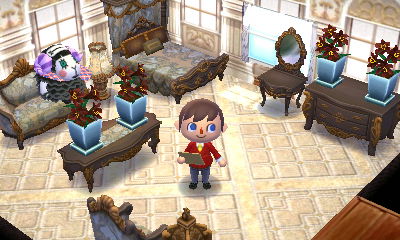
The Great Outdoors
You aren't stuck indoors in Happy Home Designer; you can design the yard as well! Furniture, trees, bushes, flowers, and even rugs can be placed outdoors. You can customize the style and color of your house, roof, door, and fence. For properties that cross a river, you can even choose the type of bridge.
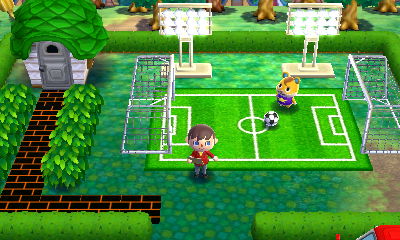
Public Facilities
Even though each villager will generally have a different request, designing home after home can get repetitive. So the presence of public facilities helps alleviate the monotony a bit. Isabelle, who is the mayor's secretary in New Leaf, will show up at times with requests for new public facilities. These include a school, a restaurant, a hospital, a hotel, a concert hall, and more.
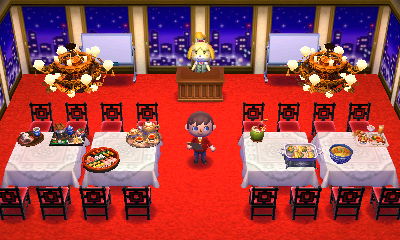
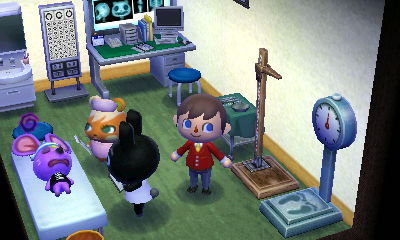
Amiibo Cards
Each regular villager will eventually show up on Main Street. But if you don't want to wait for a specific animal, you can use Amiibo cards to bring one into the game immediately. You can do this by using the Amiibo phone, which is unlocked on the 8th day of playing. You can also use Amiibo cards to summon a villager to hang out at another villager's house or a public facility. Using the Amiibo cards is optional, although the cards provide the only way of unlocking special characters such as Tom Nook, Isabelle, Resetti, and others. Note: If your 3DS is not a New 3DS, you will need an NFC Reader to scan the cards.
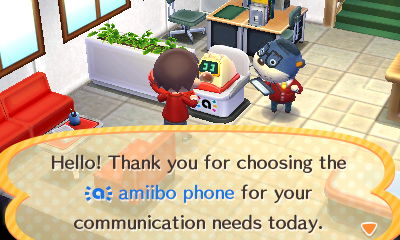
Unlocking Items
Some new items will be unlocked with each client or facility; those items will then be added to your catalog and will be available for all future projects. Sometimes a complete furniture set will be unlocked, and other times it's just a few things. While this may encourage players to keep decorating homes for all 300+ villagers, it effectively limits your creativity. For example, Mira asked me for a futuristic space theme for her house. But the space set, with relevant items like a rocket and a flying saucer, were not unlocked. Those items will remain locked until meeting another specific character later on (perhaps hundreds of designs later) who will ask for a similarly themed house. Sure, you can go back and redo a villager's house at a later date, but it seems like a ploy to artificially lengthen the game. While I understand that repeating theme requests are inevitable with over 300 characters, all items related to a theme should be available the first time.
Connectivity
Unfortunately, Happy Home Designer does not have online play, online trading, or StreetPass features. It does not connect to Animal Crossing: New Leaf, either. It does have the "Happy Home Network" however, which allows you to upload your house designs and visit homes created by other people. It works much like the Dream Suite in New Leaf. But the icons used in this mode are confusing at first. The heart icon, which I thought would mark a house as a favorite, is actually what you click to visit a home after entering its 11-digit code or scanning its QR code. Still, the Happy Home Network is a welcome addition to a game otherwise lacking online features.From time to time, there are also special design requests you can download by using the in-game 3DS on the upper floor of the office building. Essentially, it's free DLC that brings new characters and new items to use in your house designs.
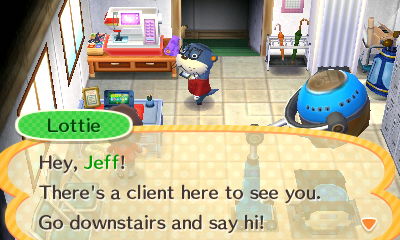
Final Verdict
Animal Crossing: Happy Home Designer can be moderately fun at times, especially to those who particularly enjoy the interior designing aspects of Animal Crossing or other games. But it doesn't take long until the repetitive gameplay becomes tedious and monotonous. It's natural for some themes to be more enjoyable than others, particularly when they match your interests. But the rest of the time is often spent drudging through a request just to make progress or unlock more furniture. On a scale of one to ten, I rate this game a mediocre...Buy Happy Home Designer at Amazon.com - Buy Amiibo Cards - Buy the NFC Reader
jvgsjeff is on Youtube, Facebook, Pinterest, Tumblr, and Twitter.
Subscribe, follow, or like for Animal Crossing pictures, videos, and more!

